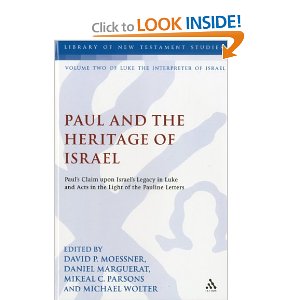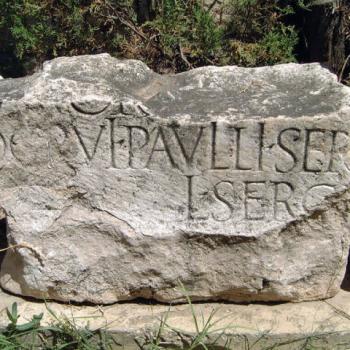The next essay in Paul and the Heritage of Israel is one by Michael Wolter, based on sociology of knowledge paradigms as a key to interpreting Paul and as a way of distinguishing Paul from what Wolter calls the later pseudepigraphic Paul (in his view this includes 2 Thessalonians, Colossians, Ephesians, and the Pastorals). Basically, Wolter wants to make a hard and fast distinction between a religion of conversion (see 2 Cor. 5.17) and a religion of tradition (see the later Paulines). The problem with this hard and fast either/or, is that it doesn’t work. Paul makes perfectly clear in his undisputed letters that he also is passing along sacred tradition (see e.g. the last supper tradition in 1 Cor. 11, and the very language of passing on of tradition in 1 Cor. 15 in regard to the credo about the death, burial, and resurrection of Jesus). While it is certainly true that in various places Paul stresses the discontinuity between Christian communities and faith on the one hand and Jewish communities and faith on the other, and he certainly affirms a theology of transformation so that one can be ‘in Christ’ it is also true that Paul draws on and affirms the Jewish Scriptures and a variety of early Christian traditions to help create the ethos of the new community. The trick is to see the balance between elements of continuity and discontinuity. Wolter is however right that in the later Paulines there is more emphasis on tradition and its being passed along. This is understandable since Paul is coming to the end of his ministry and helping his churches make the transition into the brave new post-apostolic world. And I have to say… in view of Bart Ehrman’s enormously detailed refutation of the idea that pseudepigraphal letters were a recognized literary genre and practice, and raised no moral problems, I am afraid Wolter has taken for granted something he should not, namely that there are definitely such documents in the NT, and thus that they reflect the post-Pauline reception of Paul. It should also be noted that while Wolter allows that there is some future eschatology in Colossians and Ephesians, he fails to take into account that Ephesians in particular is a different sort of rhetoric than say Romans. It is epideictic rhetoric, and the temporal focus of such rhetoric is on the present, not the future. Then too, Wolter assumes that the fact that Colossians and Ephesians assume a prior knowledge of Pauline eschatology and therefore are written to a post-Pauline situation fails to take into account the possibility that this tradition or prior knowledge came from previous oral or written communications from Paul or his co-workers like Epaphras. In any case, a religion of conversion, if it is at all successful in converting anyone, immediately becomes a religion of tradition, for there has to be teaching of the new converts once they become followers of Christ. Even if it is true that we find in Ephesians, Colossians and the Pastorals an attempt to recontextualize Paul’s theology of grace and justification, there is no good reason why Paul could not have been the one to do this himself when new situations presented themselves with new problems, and to some degree new audiences as well. And one more point— all of the Pauline letters are addressed to those who are already Christians. The fact that some of them reflect a theology of conversion and some do not is hardly surprising, and does not necessarily reflect chronological development from a religion of conversion to one of tradition. It is simply not the case, even in the case of the Pastorals, that one can say a religion of conversion is left behind and replaced by a religion of tradition, especially when we know that conversions continued to happen in these communities long after Paul died, indeed well into the second century. It is interesting however that Wolter, accepts that Luke was the sometime companion of Paul and was raised in the Pauline theological tradition, and that his portrait of the evangelizing Paul is on target (p. 68– and compare his 2008 Luke commentary). He adds that Luke differs from Paul in this respect— his whole aim in Luke-Acts is to show that Christianity is a religion of tradition with a rich heritage in Jewish salvation history.













